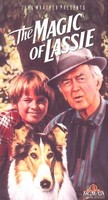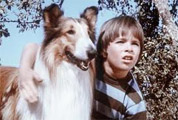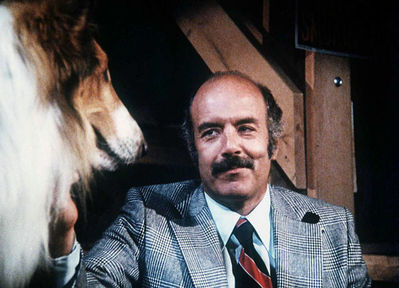
Content:
After the death of his son and his daughter-in-law, Clovis Mitchell, a Californian wine grower, takes his grandchildren Kelly and Chris home and cares for them. When the children arrive at his house, they find a little baby dog, a border collie, and call her Lassie.
Mr. Jamison, a rich man from Colorado, wants to buy Mr. Mitchell’s wine-growing estate but Clovis denies to sell his family property. As an act of taking revenge, Mr. Jamison claims that Lassie is his property and that she got lost when she was little. When he threatens with going to the police, Clovis gives in and Jamison finally takes Lassie to Colorado.
Especially Chris suffers hardly and Lassie does not like her new owner so she decides to walk all the way back to California. Meanwhile, Chris hitch-hikes to Colorado to find his beloved dog, but he is stopped by the police and his grandfather.

In the end, Lassie is back and everyone, especially the little boy, is happy.
Genre
The Magic of Lassie was produced by Don Chaffey in the USA in 1978. It is a fictional drama and belongs to the genre of adventure. The target group are children and families.
An adventure film is characterised by an exciting plot that is mostly embedded in an exotic and fascinating landscape. Although it is very close to action films, the emphasis is not on violent and brutal scenes, but on topics like travel, exploration, discovery or quest (filmsite.org).
The main goal is mostly not education or reflection about oneself, but as you can see in Lassie just and only entertainment. Adventure films try to take the spectators with them in the fabulous story and life of the film’s characters and free them from the boredom of their daily lives. In adventure films, spectators should relax and also discover adventure through the eyes of the ‘hero’.
The protagonist’s development is not so much in the focus as the plot itself, which is easy to understand and not complicate. The hero is mostly brave, altruistic and clever and often confronted with a mean counterpart. Finally, the good wins against the bad and it ends happily.
Since the 1980s, adventure became an independent genre and it developed a lot, but it exists much longer (film-fokus.de).
Interpretation:
In the film, Lassie is without any doubt the main character and heroine. Not only the title includes her name, but the whole plot is set around her presence.
Right from the beginning, the border collie is personalized and addressed. The family talks to her directly as they say “Hey Lassie, how do you do?” or “Good Night, Lassie.” Nowadays, it is normal to talk to pets, but at the time when the film was produced, dogs were not treated in such a human way but they were seen as useful animals with a specific purpose like tending sheep or guarding a house (Greiffenhagen/Buck-Werner 2009).
The dog has a strong character and she has her own opinion. She decides who she finds sympathetic and who she does not like, e.g. she cuddles up to Chris whereas she barks at Mr. Jamison. Cleverness, intelligence, braveness and empathy are just some of her personal traits and typical characteristics of a heroine, but she is also understanding, loveable, sweet and has her own will. Furthermore, she is stubborn and she puts up resistance against her new owner when he takes her away, so that means that she opposes the bad or evil (Chaffey 1978, 21:19, 27:07).
Moreover, the spectators can identify with Lassie through the camera perspective. Lassie is not always in the focus and sometimes the camera portrays her point of view. The audience is involved in the plot and can put themselves in Lassie’s place.
Furthermore, she is a full member of the family and the best friend of Chris because he can rely on her. At the beginning, she was a symbol of hope because when the children’s parents died, Lassie came into the family and gave hope to Chris and Kelly. As they love her so much, their grandfather does not want to give her away and he rejects the money Mr. Jamison offers him. Besides, the children or especially Chris solidarizes with her and says: “If she should not be a member of our family anymore, than I do not want to be a member either (Chaffey 1978, 23:48).” That proves that strong emotions are connected to her as Chris cries and is not only angry with his grandfather, but he says that he hated him, when Lassie is finally given away because Mr. Jamison threatens Mr. Clovis with an advocate.

According to the film genre, one has to mention that the whole plot is embedded in an exotic landscape. But it is not only the nature and her long walk home that makes her excursion exotic, but also the scenes when Lassie visits a wrestling fight or when she sleeps next to the campfire – the symbol of adventure and liberty. She is so courageous that she survives in the wasteland.
In addition, there are also some comical scenes in which Lassie participates in order to entertain the audience as it is the main goal of adventure films. One of those scenes is when Lassie is standing on a diving board above the pool and Mr. Jamison tries to catch her. Lassie jumps away, but the man falls into the water. That makes him so furious that he seeks the dog by helicopter. Another funny scene is when Lassie goes to the wrestling fight and when the two craftsmen who found her on the street and helped her say that this dog is totally harmless, it is exactly in this moment Lassie tears the wrestler’s dress. It is also exciting and funny at the same time when she runs away from the police and the policemen are unable to catch the dog.
Another interesting point that strongly refers to the film’s genre is her adventure she experiences on her way back to California. She walks a very long distance because she misses the Mitchell family and because they miss her. Embedded in exotic places, she tries everything to get home and finally, she arrives at the wine growing estate.
Moreover, you can also find some parallels between Lassie and Chris, the little boy. Both miss each other so much that Lassie walks home to California and Chris hitchhikes to Colorado. They are both brave and do unconventional things. Finally, they both get home and there is a happy ending.
General Point
One very interesting general aspect the film focuses on is the evolution of dogs. The modern dog’s Latin name is Canis Familiaris which refers to the family or the dog as a member of the family. Since he is a descendant of the grey wolf (Canis Lupus), he has undergone a drastic development (pbs.org).
When people think of wolfs, what they associate with this animal is mostly fear, danger and brutality, as it is often described in fairy tales, whereas dogs nowadays have become the best friend of human beings.
Many centuries throughout history, dog were used for different purposes like watchdogs or herding dogs. It was in the 20th century that the human-dog-relationship started to change and dogs became family members and the humans’ best friends. The film picks up this aspect and presents the change in the human-animal relation. Lassie is presented as the best friend of Chris and a full family member. Strong emotions are connected to her as the little boy is very angry with his grandfather when he gives the dog to Mr. Jamison.
Moreover, the dog is portrayed in a very human way, as an individual with character traits, a strong will and emotions which are originally human traits. She is empathetic, clever and she knows whom she can trust instead of being an unpredictable, dangerous creature. That is what makes her a heroine and why the audience can identify with the protagonist even though it is not a human person but an animal.
Lassie portrays the dog in the new, positive way that came up in literature and film in the mid or late 20th century and helped to change society’s attitude towards dogs. One effect of this representation of border collies in this film is that their popularity grows and that more and more people want to have an own dog that is part of their family because they see how clever and self-willing dogs can be.
Reflection
One has to distinguish between films in which animals are presented in a scientific way (e.g. documentaries) and fictional films in which animals are independent characters with heart and soul that can sometimes even talk like in Ratatouille.
In Lassie, the dog is the central protagonist with a strong personality: She is courageous, full of will-power, clever, understanding, loveable and sweet. When it was published, still a lot of dogs were not just a member of the family, but they had a job to do. So in this aspect, the film shows the current developments. It covers most points of the adventure genre.
Chris deeply loves his companion and he risks his life when hitch-hiking to Colorado alone. For him, Lassie is not just an animal, but a loyal and understanding friend to him with human qualities
Further reading:
Minton, Lynn (1978): The Magic of Lassie. McCall’s Vol. 106. Gruner & Jahr: USA.
Owen, Peter (2005): Lassie. The extraordinary story of Eric Knight and the world’s favourite dog. Dufour Editions: London.
Illustration:
Film Trailer: https://www.youtube.com/watch?v=paa4TQAkbek
Bibliography:
Action and adventure films: http://www.filmreference.com/encyclopedia/Academy-Awards-Crime-Films/Action-and-Adventure-Films.html (07.01.2016)
Adventure films: http://www.filmsite.org/adventurefilms.html (07.01.2016)
Evolution Library. Evolution of the dog: http://www.pbs.org/wgbh/evolution/library/01/5/l_015_02.html (22.01.2016)
Filmliste Abenteuer: http://www.film-fokus.de/filme/abenteuer/ (07.01.2016)
Greiffenhagen, S. u. Buck-Werner, O. (2009): Tiere als Therapie. Neue Wege in Erziehung und Heilung, 2.Auflage, Lettland – Nerdlen.
History of dogs and wolves: http://quatr.us/economy/dogs.htm (22.01.2016)
Pictures:
DVD cover: http://ia.media-imdb.com/images/M/MV5BMTIwMDczMTc3Nl5BMl5BanBnXkFtZTcwNTg5MDIzMQ@@._V1_SX640_SY720_.jpg (07.01.2016)
Annotations:
Direct quotations from the film are transcripted by the author of this text.